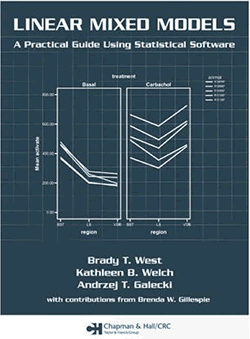
Research Professor, Division of Geriatrics/Institute of Gerontology, Medical School
Research Professor, Department of Biostatistics, School of Public Health
|
Linear Mixed Models: A Practical Guide Using Statistical Software
|
 |
Simplifying the often confusing array of software programs for fitting linear mixed models (LMMs), Linear Mixed Models: A Practical Guide Using Statistical Software provides a basic introduction to primary concepts, notation, software implementation, model interpretation, and visualization of clustered and longitudinal data. This easy-to-navigate reference details the use of procedures for fitting LMMs in five popular statistical software packages: SAS, SPSS, Stata, R/S-plus, and HLM.
The authors introduce basic theoretical concepts, present a heuristic approach to fitting LMMs based on both general and hierarchical model specifications, develop the model-building process step-by-step, and demonstrate the estimation, testing, and interpretation of fixed-effect parameters and covariance parameters associated with random effects. These concepts are illustrated through examples using real-world data sets that enable comparisons of model fitting options and results across the software procedures. The book also gives an overview of important options and features available in each procedure. Making popular software procedures for fitting LMMs easy-to-use, this valuable resource shows how to perform LMM analyses and provides a clear explanation of mixed modeling techniques and theories.
Journal of the American Statistical AssociationStata - Data Analysis and Statistical Software
CRC Press
Amazon.com
Links to additional reviews can be found on Dr. West's web page
1.1.2 Models for Longitudinal or Repeated-Measures Data
1.1.3 The Purpose of This Book
1.1.4 Outline of Book Contents
1.2.2 Key Software Developments
2.1.1.2 Levels of Data
2.1.2.2 Random Factors
2.1.2.3 Fixed Factors vs. Random Factors
2.1.2.4 Fixed Effects vs. Random Effects
2.1.2.5 Nested vs. Crossed Factors and their Corresponding Effects
2.2.2 General Matrix Specification
2.2.2.2 Covariance Structures for the Ri Matrix
2.2.2.3 Group-Specific Covariance Parameter Values for the D and Ri Matrices
2.2.4 Hierarchical Linear Model (HLM) Specification of the LMM
2.3.2 The Marginal Model Implied by an LMM
2.4.1.2 General Case: Assume theta is unknown
2.4.3 REML vs. ML Estimation
2.5.2 Computational Problems with Estimation of Covariance Parameters
2.6.1.2 Hypotheses: Specification and Testing
2.6.2.2 Likelihood Ratio Tests for Covariance Parameters
2.6.3.2 Alternative Tests for Covariance Parameters
2.7.2 The Step-Up Strategy
2.8.1.2 Standardized and Studentized Residuals
2.8.3 Diagnostics for Random Effects
2.9.2 Intraclass Correlation Coefficients (ICCs)
2.9.3 Problems with Model Specification (Aliasing)
2.9.4 Missing Data
2.9.5 Centering Covariates
3.2 The Rat Pup Study
3.2.2 Data Summary
3.3.2 Model Specification
3.3.2.2 Hierarchical Model Specification
3.4.2 SPSS
3.4.3 R
3.4.4 Stata
3.4.5 HLM
3.4.5.2 Preparing the Multivariate Data Matrix (MDM) File
3.5.2 Likelihood Ratio Tests for Residual Variance
3.5.3 F-tests and Likelihood Ratio Tests for Fixed Effects
3.6.2 Comparing Model 3.2B Results
3.6.3 Comparing Model 3.3 Results
3.7.2 Covariance Parameter Estimates
3.9 Calculating Predicted Values
3.9.2 Population-Averaged (Unconditional) Predicted Values
3.10.1.2 Conditional Studentized Residuals
3.10.2.2 Influence on Covariance Parameters
3.11.2 Syntax vs. Menus
3.11.3 Heterogeneous Residual Variances for Level 2 Groups
3.11.4 Display of the Marginal Covariance and Correlation Matrices
3.11.5 Differences in Model Fit Criteria
3.11.6 Differences in Tests for Fixed Effects
3.11.7 Post-Hoc Comparisons of LS Means (Estimated Marginal Means)
3.11.8 Calculation of Studentized Residuals and Influence Statistics
3.11.9 Calculation of EBLUPs
3.11.10 Tests for Covariance Parameters
3.11.11 Reference Categories for Fixed Factors
4.2 The Classroom Study
4.2.2 Data Summary
4.2.2.2 Preparing the Multivariate Data Matrix (MDM) File
3.2 Models Specification
4.3.2.2 Hierarchical Model Specification
4.4.2 SPSS
4.4.3 R
4.4.4 Stata
4.4.5 HLM
4.5.2 Likelihood Ratio Tests and t-tests for Fixed Effects
4.6.2 Comparing Model 4.2 Results
4.6.3 Comparing Model 4.3 Results
4.6.4 Comparing Model 4.4 Results
4.7.2 Covariance Parameter Estimates
4.9 Calculating Predicted Values
4.9.2 Plotting Predicted Values Using HLM
4.10.2 Residual Diagnostics
4.11.2 Setting up Three-Level Models in HLM
4.11.3 Calculation of Degrees of Freedom for t-tests in HLM
4.11.4 Analyzing Cases with Complete Data
4.11.5 Miscellaneous Differences
5.2 The Rat Brain Study
5.2.2 Data Summary
5.3.2 Model Specification
5.3.2.2 Hierarchical Model Specification
5.4.2 SPSS
5.4.3 R
5.4.4 Stata
5.4.5 HLM
5.4.5.2 Preparing the MDM File
5.5.2 Likelihood Ratio Tests for Residual Variance
5.5.3 F-tests for Fixed Effects
5.6.2 Comparing Model 5.2 Results
5.7.2 Covariance Parameter Estimates
5.9 Diagnostics for the Final Model
5.10 Software Notes
5.10.2 EBLUPs for Multiple Random Effects
5.11.2 Fitting the Marginal Model
5.11.3 Repeated-Measures ANOVA
6.2 Autism Study
6.2.2 Data Summary
6.3.2 Model Specification
6.3.2.2 Hierarchical Model Specification
6.4.2 SPSS
6.4.3 R
6.4.4 Stata
6.4.5 HLM
6.4.5.2 Preparing the MDM File
6.5.2 Likelihood Ratio Tests for Fixed Effects
6.6.2 Comparing Model 6.2 Results
6.6.3 Comparing Model 6.3 Results
6.7.2 Covariance Parameter Estimates
6.8.2 Conditional Predicted Values
6.9.2 Diagnostics for the Random Effects
6.9.3 Observed and Predicted Values
6.11 An Alternative Approach: Fitting the Marginal Model with an Unstructured Covariance Matrix
7.2 The Dental Veneer Study
7.2.2 Data Summary
7.3.2 Models Specification
7.3.2.2 Hierarchical Model Specification
7.4.2 SPSS
7.4.3 R
7.4.4 Stata
7.4.5 HLM
7.4.5.2 Preparing the Multivariate Data Matrix (MDM) File
7.5.2 Likelihood Ratio Tests for Residual Variance
7.5.3 Likelihood Ratio Tests for Fixed Effects
7.6.2 Comparing Software Results for Model 7.2A, Model 7.2 B, and Model 7.2C
7.6.3 Comparing Model 7.3 Results
7.7.2 Covariance Parameter Estimates
7.9 Diagnostics for the Final Model
7.9.2 Diagnostics for the Random Effects
7.10.2 The Ability to Remove Random Effects from a Model
7.10.3 The Ability to Fit Models with Different Residual Covariance Structures
7.10.4 Aliasing of Covariance Parameters
7.10.5 Displaying the Marginal Covariance and Correlation Matrices
7.10.6 Miscellaneous Software Notes
7.11.2 The Step-Up vs. Step-Down Approach to Model Building
7.11.3 Alternative Uses of Baseline Values for the Dependent Variable
A.1.2 SPSS
A.1.3 R
A.1.4 Stata
A.1.5 HLM
http://www.crcpress.com/ecommerce_product/product_detail.jsf?catno=C4800
http://www.stata.com/bookstore/lmm.html
http://www.amazon.com/Linear-Mixed-Models-Practical-Statistical/dp/1584884800